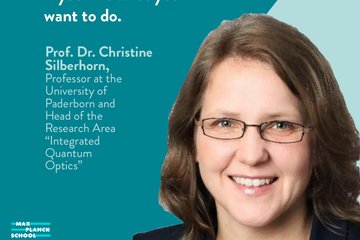Turning lens-coating to cutting-edge research
Research team detects emission of coherent light from 2D materials for the first time
A research team including MPSP alumnus Dr. Heiko Knopf and Fellow Dr. Falk Eilenberger recently published a scientific article in the prestigious journal Nature Communications. Heiko now told us in an interview, what eyeglasses have to do with quantum communication and why this might shape future Photonics research.

Heiko, thank you very much for taking the time for this interview today. At the end of 2021, your paper entitled "Spatial coherence of room-temperature monolayer WSe2 exciton-polaritons in a trap" was published - congratulations again! Could you briefly explain for those not doing research in your field what is behind this impressive title?
"Gladly! For the article, we tried to excite very thin, atomically monolayered materials – so-called 2D materials – to emit photons from them. These then have similar properties as a conventional laser, but are much smaller and, because they are so thin, are also in some respects very different from multilayered laserlightsources. We have now been able to demonstrate for the very first time that it is also possible to generate coherent light in such monolayers at roomtemperature – that means, the light that is emitted oscillates in phase with each other and the different light waves are not displaced from each other.
We accomplished this by packing these monolayers into an optical oscillating system of two mirrors. The mirrors are precisely matched to the energy of this monolayer to be able to excite (and de-excite) it very efficiently."
How exciting (excuse the pun)! There was a large team of researchers involved in the article - what exactly did you do?
"Yes, our team for this paper consisted of researchers at the University of Jena, the Fraunhofer IOF, the University of Würzburg and the University of Oldenburg. The colleagues in Würzburg and Oldenburg were responsible for characterizing the monolayer sample and were able to measure with the help of a Michelson interferometer that exactly this coherent light is emitted from it.
We in Jena had previously fabricated the monolayers and the sample system for it. We used a special process for this, in which the material is treated so gently that it remains optically active. You know, that is not so easy: After all, such 2D materials consist only of surface, i.e., of a single, wafer-thin atomic layer. If you want to work with them and cover them with another material, for example, you have to be very careful not to chemically alter or mechanically break the monolayer. The process we developed for this here in Jena at Fraunhofer institute was originally invented for coating plastic lenses for eyeglasses. We have now modified it so that it was suitable for our 2D materials."
So you've gone from practice back to science – normally it's the other way around, right? Could your findings now again be used for further practical applications or future research?
"Yes, that was indeed a rather unusual path – from a practical application back to research. Our results now open up many new possibilities for further basic research, for example on atomically small light sources. These could achieve a much higher resolution than previous light sources, because the light does not have to be focused – it is already available in atomic size. They could also be used to generate entangled photons and to develop light sources for quantum communication. And these are just two examples of applications – I'm already very excited about what will develop from our research in the next five or ten years."
So are we! Thank you very much for your time!












